“Sorry, I’m just looking around” is, probably, one of the worst phrases you can hear from a customer if you’re working in retail because it means a lack of buying intention. However, eCommerce has an equivalent of that, and that’s an abandoned shopping cart.
You might be thinking, “Sure, it happens sometimes, but is it such a big deal?” Hold on to your seat. 70% of digital shopping carts were abandoned in 2021, and only 30% of customers actually ordered what they wanted.
That’s an absolutely massive revenue loss for the sellers. Other sources suggest that the abandonment rate may be even higher, up to 84%. At least 15% of those carts can be recovered.
How do you break the spell of abandoned carts and motivate your visitors to finish their purchase? Meet abandoned cart emails. They can help you reignite your customers’ interest and incentivize them to move forward with their order. Let’s find out what makes an effective abandoned cart recovery email (spoiler alert, you’ll need more than one).
Content:
- What are abandoned cart emails?
- Why do customers abandon their carts in the first place?
- Why should you be sending abandoned cart emails?
- 20 abandoned cart email subject lines to use
- 13 examples of abandoned cart emails and what we can learn from them
- Start using abandoned cart emails to regain lost sales
What are abandoned cart emails?
The term abandoned cart means that your customer had some interest in your offer but, for some reason, lost it. Maybe, they put one or two items in their cart. Or, perhaps, they got all the way to the checkout, but something stopped them. Whatever the case is, they may need a little push from you to help them get back on track.
An abandoned cart email is a type of triggered message targeting users who got stuck at some point in the sales funnel. These emails act like gentle reminders — they are meant to motivate customers to complete their order.
To get your customers back, you need to be persuasive. Here’s what an ideal abandoned cart email strategy looks like:
- First email — polite reminder. The goal is to reach your customers while they’re still in a buying mood. As a rule, 60% of users come back to make a purchase 24 hours after they get personalized emails about their incomplete orders.
- Second email — offering some help. At this step, you need to find out what’s stopping them from completing the order. Provide your subscribers with all valuable information they might need — link to your FAQ section, offer a chat with a support agent, or share an explainer video. You can also include social proof or cross-sell by adding similar options your potential buyer might like.
- Third email — generating FOMO. Don’t let your customers procrastinate any longer — and make sure you don’t spend too much time and resources on indifferent window shoppers, either. Add a limited-time offer like free shipping or a discount to incentivize cautious users to take action.
You may want your first reminder to be sent on the same day or even within an hour after the cart has been abandoned; otherwise, the momentum will be lost. The second reminder can be sent the next day. Then, ideally, you’ll need to wait a day or two before you send your third email — you don’t want to overwhelm your customers or scare them away.
The best time to send an abandoned cart email may vary depending on your niche. The higher your price tag, the more mindful you should be about your sending frequency. For high-ticket items, your audience will need more time and nurturing. In that case, you may have to increase the gaps between your abandoned cart emails.
Why do customers abandon their carts in the first place?
According to Statista, these are the main reasons why your visitors put items in their cart but never complete the purchase:
- The price is too steep.
- You don’t deliver to their region.
- They found a better offer.
- The delivery is too slow or too expensive.
- You don’t offer their preferred payment method.
- You provided them with a poor shopping experience.
- They were asked to fill out too many forms.
- They had technical problems accessing your website.
- Your website looks suspicious.
- You don’t have a clear return policy.
- They got busy or distracted.
In general, higher-ticket items such as gadgets or jewelry have higher abandonment rates than essential products like groceries. Also, mobile users are twice as likely to abandon a cart compared to desktop shoppers because around 28% of websites aren’t mobile-friendly, especially when it comes to checkout.
Now that we’ve identified the main causes, let’s look for a potential cure.
Why should you be sending abandoned cart emails?
This type of email is fantastic for winning hesitant customers back and helping them fall in love with your brand. On average, highly personalized and well-written abandoned cart emails have open rates of 38% and conversion rates of 28%.
Some B2C marketers report that more than 40% of their abandoned cart emails get opened and that 50% of the users who click on them end up purchasing. To sum up, this is the second most converting type of email, right after welcome emails.
Did you know that 87% of consumers who abandon their carts just need a little reminder to get back to their purchase? If you don’t send timely abandoned cart recovery emails, you risk losing at least 26% of them to your direct competitor.
You can use abandoned cart emails to address common customer concerns:
- Compare your product to its alternatives and highlight your advantages.
- Offer free delivery or a discount.
- Help your customers get around the high price by encouraging them to use buy-now-pay-later services.
- Clarify your return policy and mention your money-back guarantee if you have one.
Your ultimate goal is to find out what holds your visitors back and target their unique pain points in your abandoned cart emails. You can conduct an email survey to find out what kinds of fears and objections your existing customers had when they were first ordering from you.
20 abandoned cart email subject lines to use
Approach abandoned cart email subject lines with caution — you don’t want to sound intrusive or spammy and accidentally turn your potential customers off. Use short, catchy subject lines to pique your subscribers’ curiosity and motivate them to order your best-selling items while the supplies last.
After analyzing dozens of abandoned cart recovery emails, we’ve gathered some ideas for you:
- You forgot to complete your purchase
- Still interested in these items?
- Hurry up! The product you wanted is selling out quickly
- Oops, you forgot something in your cart
- Don’t forget to purchase your faves
- Wanna take another look?
- You left an item in your cart
- Looks like you have forgotten something…
- X is still in your cart
- We saved your items
- Ready to continue shopping?
- Get back to where you started
- Just a heads up
- Don’t let free shipping go to waste
- This product is waiting for you
- Hey, still interested in X?
- Is everything cool with your transaction?
- You seem to have been interrupted
- Psst… you left something behind
- Finish your order
As you’ll see, the best abandoned cart emails are the ones that skillfully trigger urgency while also empathizing with customers — keep that mind when working on your subject lines.
13 examples of abandoned cart emails and what we can learn from them
Let us show you some great examples of abandoned cart email design and copywriting. We’ve handpicked messages that seem to have it all — they’re witty, memorable, converting, and mobile-friendly. Read on to learn how other brands effortlessly recover abandoned orders and save their revenue, one email at a time.
Show them what you’ve got
If you’re selling aesthetically pleasing items that perfectly pair with each other, go ahead and include multiple options in your abandonment cart email, especially if you suspect that your customers are unsure what they want. Give them plenty of options and show them how well the items work together.
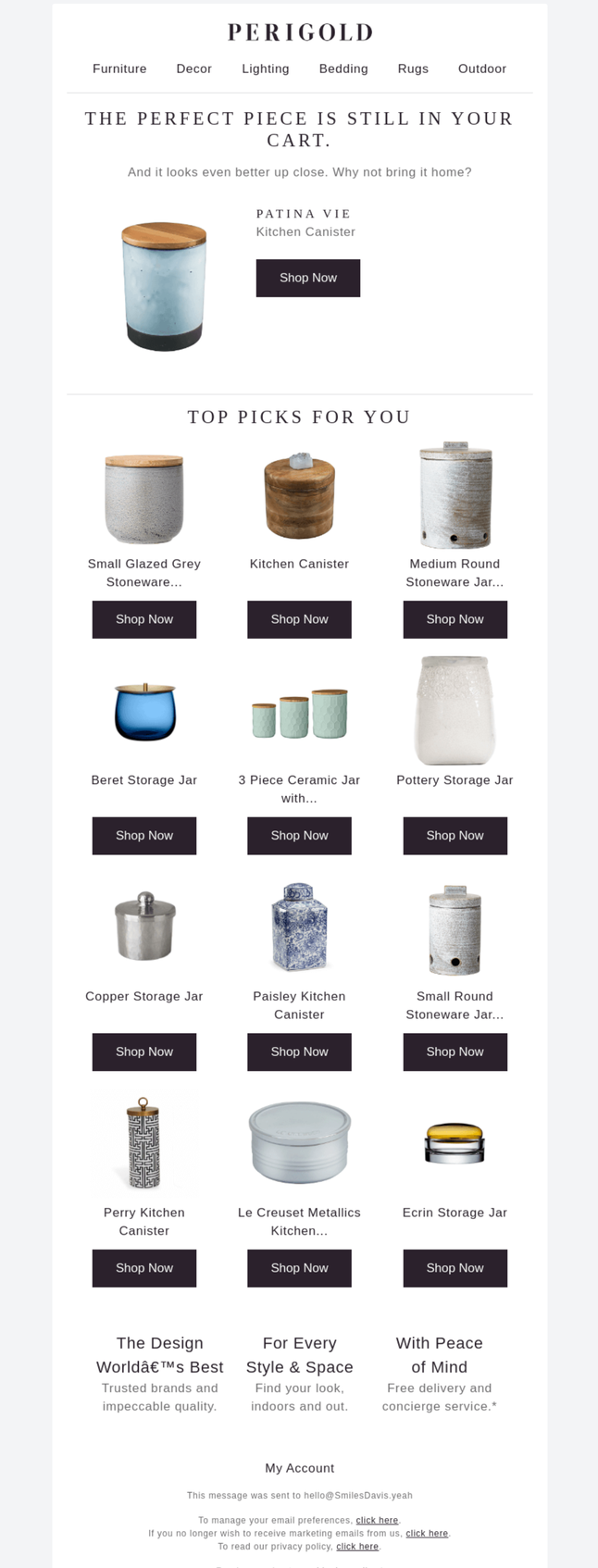
This personalized recommendation email creates a great first impression. It not only features an array of appealing products but also mentions other important perks such as free delivery and concierge services.
Walk your customer through the first steps
If you know for a fact that your product or service requires some getting used to, account for that and send value-packed abandoned cart emails before your customers decide to part with your brand forever.
Zapier shows us how it’s done.

Consider every abandoned cart an opportunity to educate and nurture your potential customers. Whatever trouble they ran into, a simple reminder paired with a guide or a helpful tip can change their mind and encourage them to give it another try.
Stay true to your brand
An abandoned cart recovery email is no reason to get all pushy. In fact, it’s even better if your message sounds like a friendly remark rather than a straight-up sell — it’ll help you stand out and reveal a bit of your brand personality, too.
Check out how this digital nomad gear brand recovers abandoned carts by sending elegant but informal reminders.
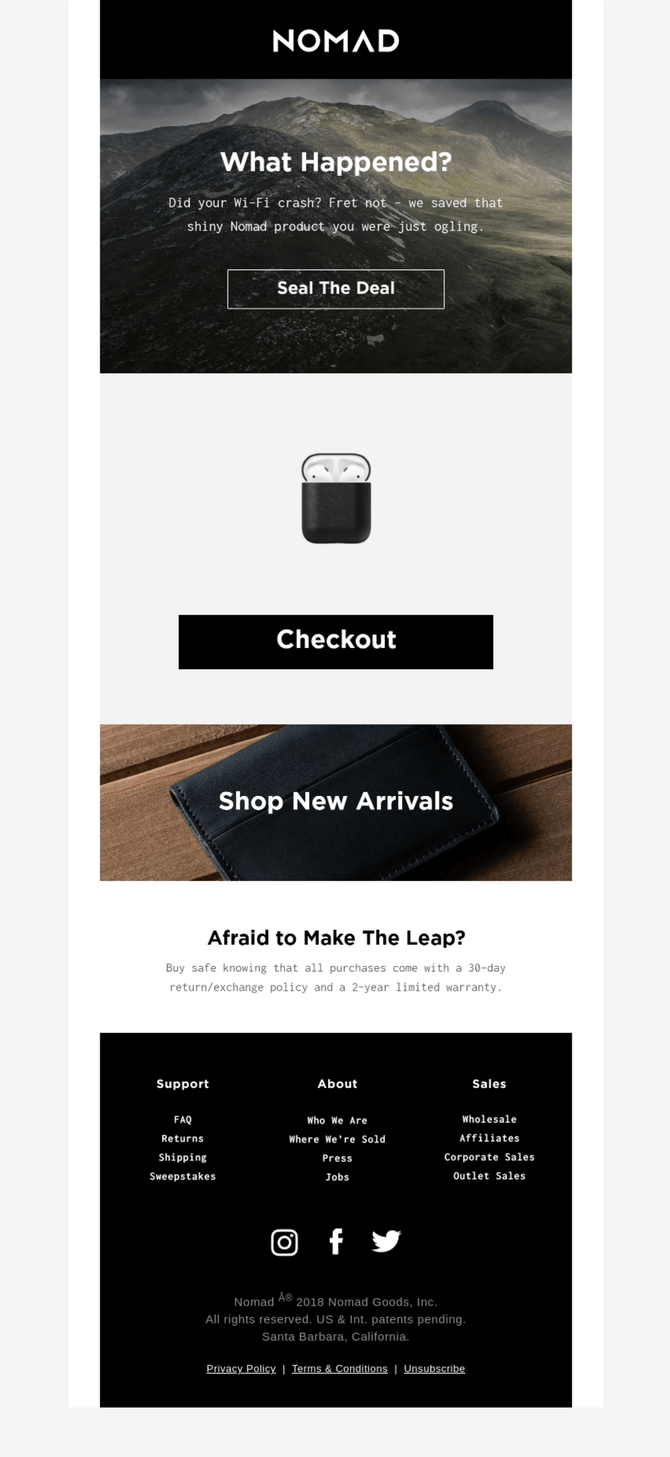
This email has a trendy dark color palette and gorgeous visuals, another step away from the conventional tacky commercial emails. The brand also mentions its generous warranty and 30-day return policy to give its customers total peace of mind when buying expensive gadgets.
Keep it simple
If you’re out of ideas, check out this minimalistic abandoned cart recovery email example. It has everything a proper reminder should include: an incentive, a nice product photo, a clear CTA, and a way to connect with a shop assistant.
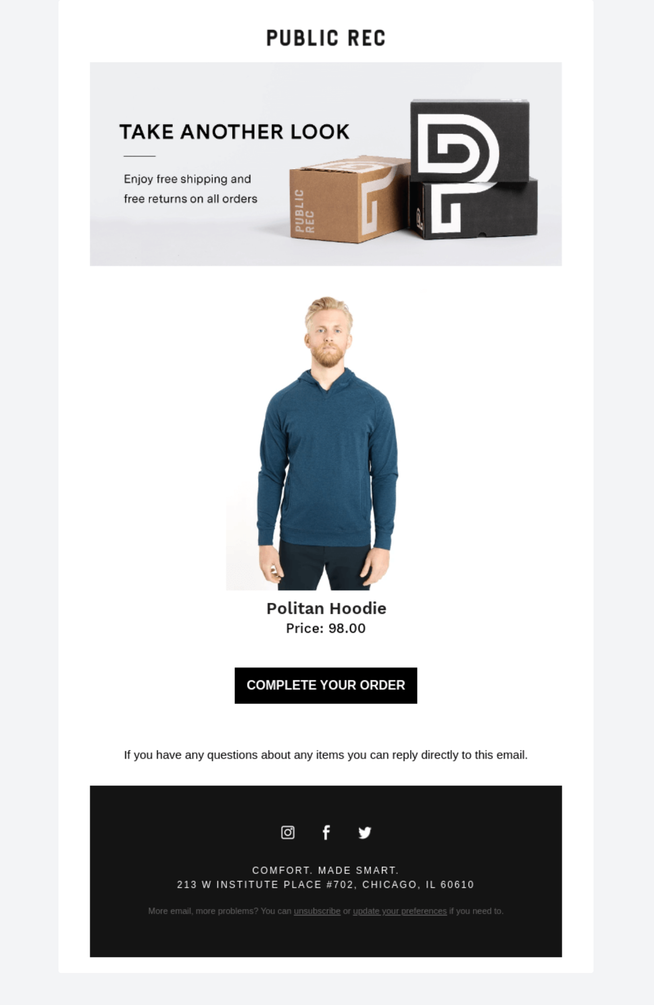
On the one hand, this email includes just a single product and nothing else, on the other hand, it’s completely distraction-free and very skimmable, so that’s a trade-off worth making.
Compliment your customer’s choice
Use abandoned cart emails to explain why you think your customer made a great choice. Touch upon the qualities of the product in question, mention how it’s made, or what it feels like to use it.
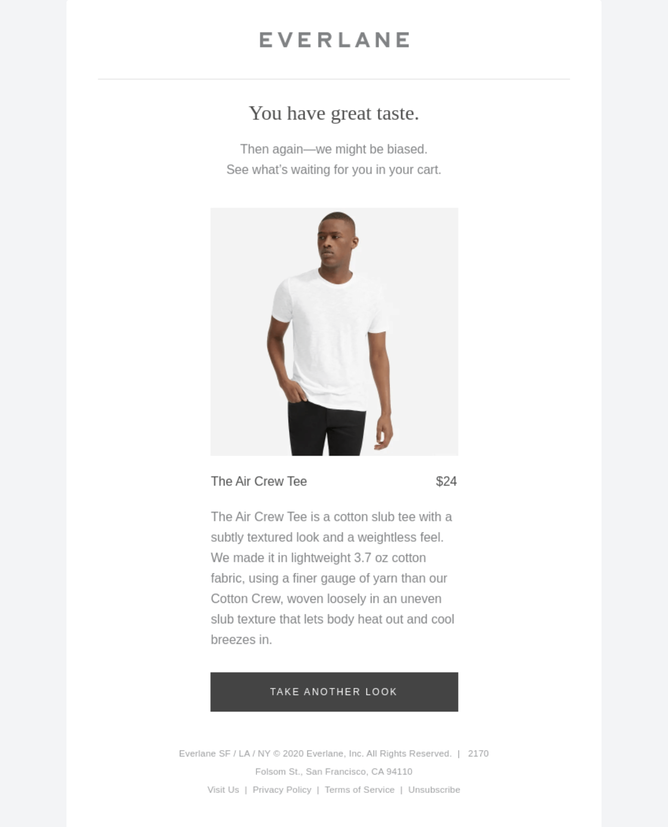
This example feels like a genuine recommendation rather than an automated reminder, and, therefore, it has higher chances to get noticed. The whole message is kept above the fold for better readability.
Give your customer a solid reason to come back
A little discount goes a long way when you need to establish trust and get a new visitor familiar with your products. Winc knows that and offers a nice bonus to users wishing to recover their shopping cart.
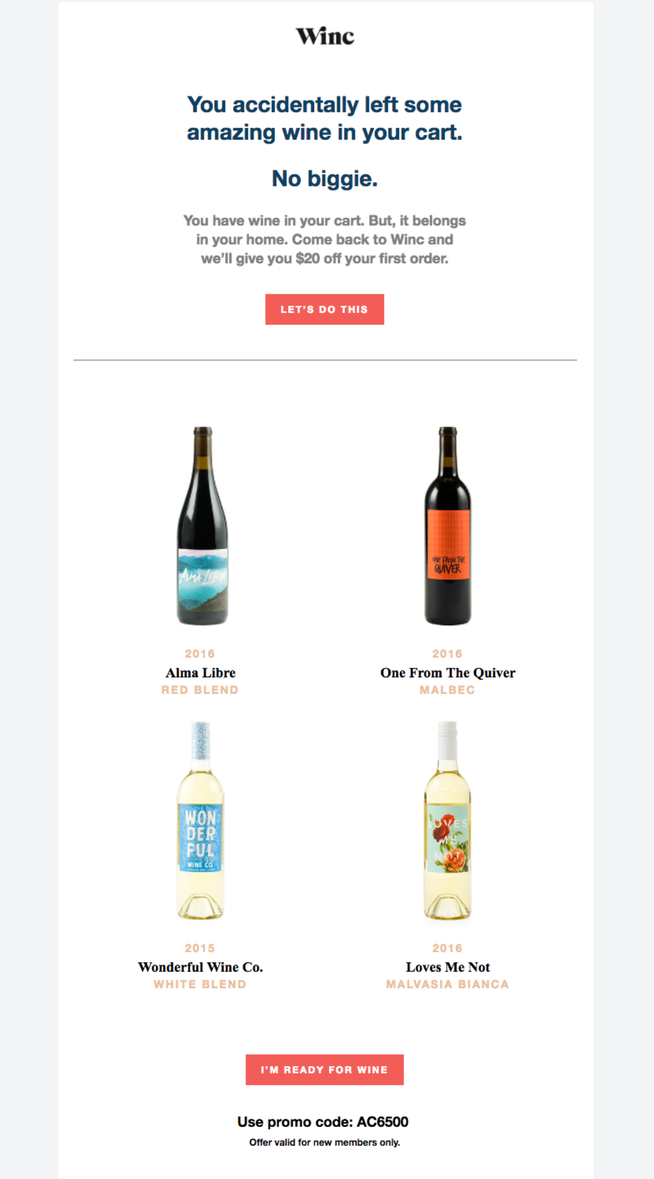
Hands down, this might be the most efficient way to make forgetful customers come back and order even more than they intended to. We also love this example because of how quirky and unpretentious it is, even though wine is considered one of the most conservative of all consumer products.
Show empathy and understanding
Instead of rushing your customer into a purchase, cheer them up and make them feel understood. They probably forgot about their order because they have a lot on their plate, so there’s no need to make them feel guilty about it.
Headspace knows all that and respects its users’ time and choices.
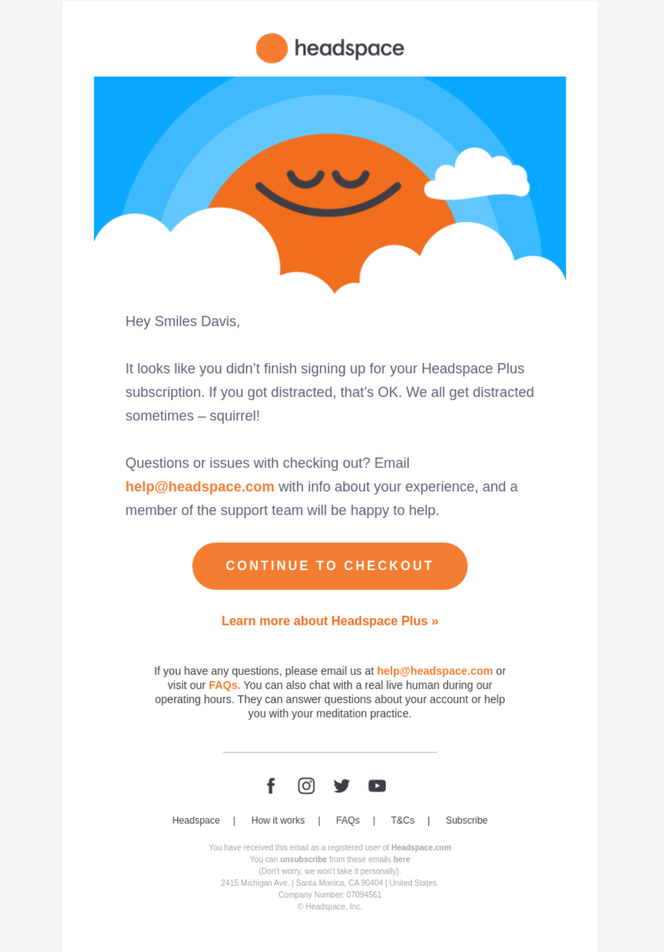
In its abandoned checkout emails, Headspace politely offers help and gives useful links to in-depth tutorials on how to get started with the platform. This is a great way to build trust with your audience and provide them with a positive experience from day one.
Leverage the power of customer testimonials
Convince your recipient to get back to their unfinished order by sending them happy reviews from customers who have already bought that very product. This is guaranteed to boost their interest and buying desire. Also, it’ll help you demonstrate that there’s high demand for your offer.

Make sure that the social proof you’re using is genuine and verifiable — include Instagram handles or photos of the people who wrote those reviews.
Use subtle psychological triggers
When dealing with a savvy audience, you need to be a bit more subtle about your abandoned cart recovery techniques. For instance, don’t try to lure them in by offering them tons of coupons and free delivery at the same time — they might think that it’s too good to be true. Instead, simply let them know that their order is qualified for free delivery, just like in this example.
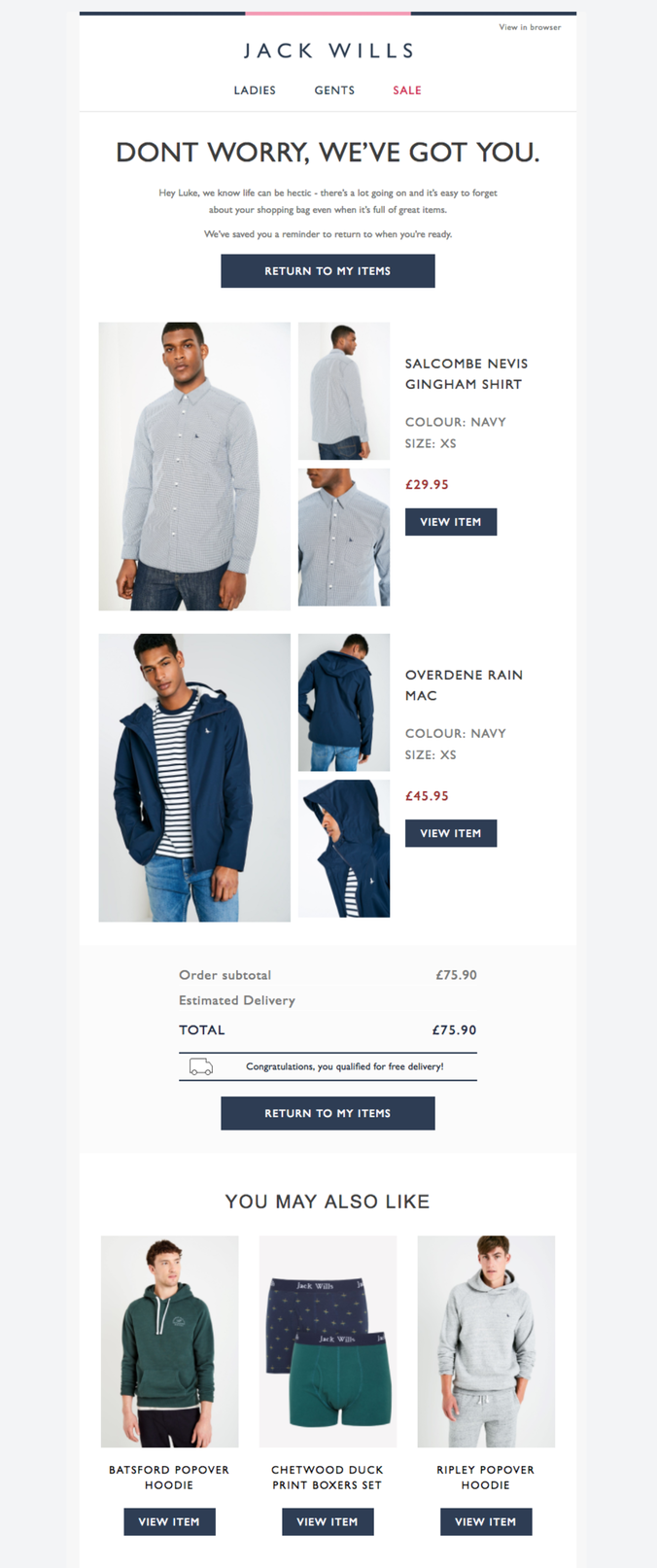
Another thing we like about this email is that it’s intentionally designed to resemble a typical checkout experience. This way, the recipient will be more mentally prepared to complete the order because it looks so intuitive and straightforward.
List your store’s advantages
Use abandoned cart emails to sum up the reasons why people should buy from you, especially if you suspect that your customers simply don’t know what they’re missing out on. Even renowned brands like Dyson do that because it’s hard for consumers to keep track of what every big online store has to offer.
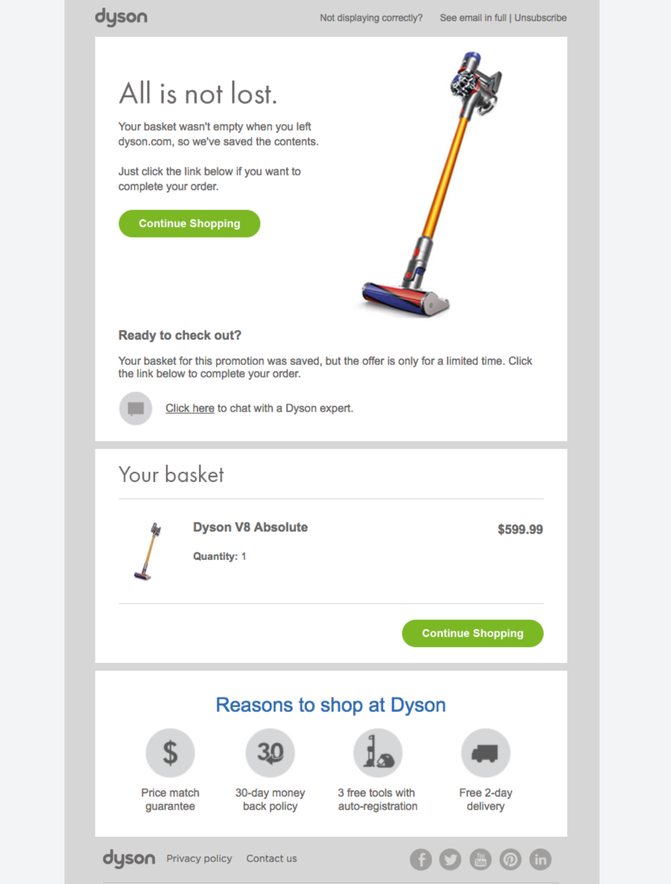
This abandoned cart recovery email sounds very polite and even humble, considering that Dyson offers impressive shipping and return options. The link to the customer service chat helps buyers learn more about the device of their choice.
Don’t take it too seriously
If you want your emails to outshine those from your competitors, you need to take a fresh, clever approach. Sometimes, it helps to break the mold and try something entirely different — here’s a proof from Whisky Loot.
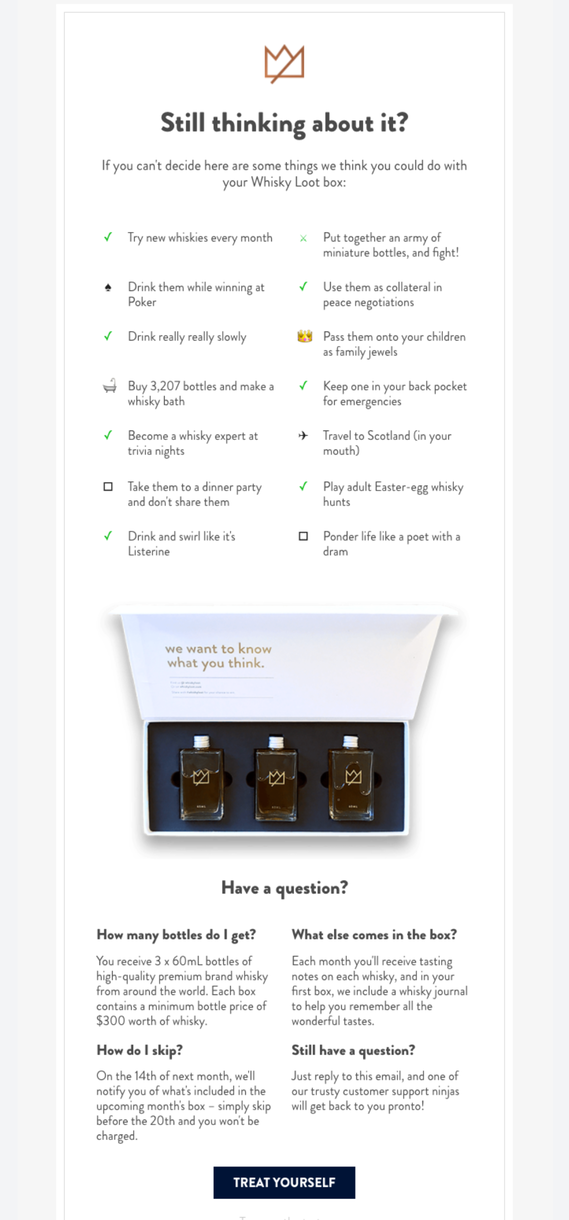
As you can see, this is another kind of abandoned cart email. It’s written with tongue in cheek — not something you’d normally expect from a whisky company. However, that’s what makes it grab the eye. It also has a concise, no-fluff FAQ section to help indecisive customers overcome their doubts.
Get personal
Another way to stand out from the crowd of generic emails is to give yours a personal touch. And what can be more personal than sending it from your own name and initiating an actual dialogue with the customer?
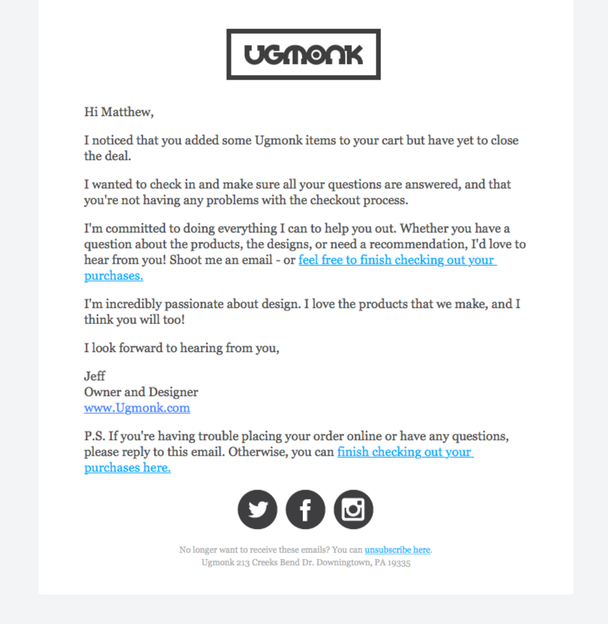
This plain-text email ticks every box. It’s personalized, friendly, and helpful, and it feels like it was written and sent manually, so it automatically makes the reader pay full attention to it.
Utilize scarcity marketing tactics
Artificially created scarcity isn’t the best tactic to employ — your customers may end up feeling misled and taken advantage of. However, if you sell something truly rare, why not make it clear in your abandoned cart emails? Your customers deserve to know what they’re risking to lose if they don’t proceed with their order.
Here’s an absolutely justified case of using scarcity marketing to sell artworks.
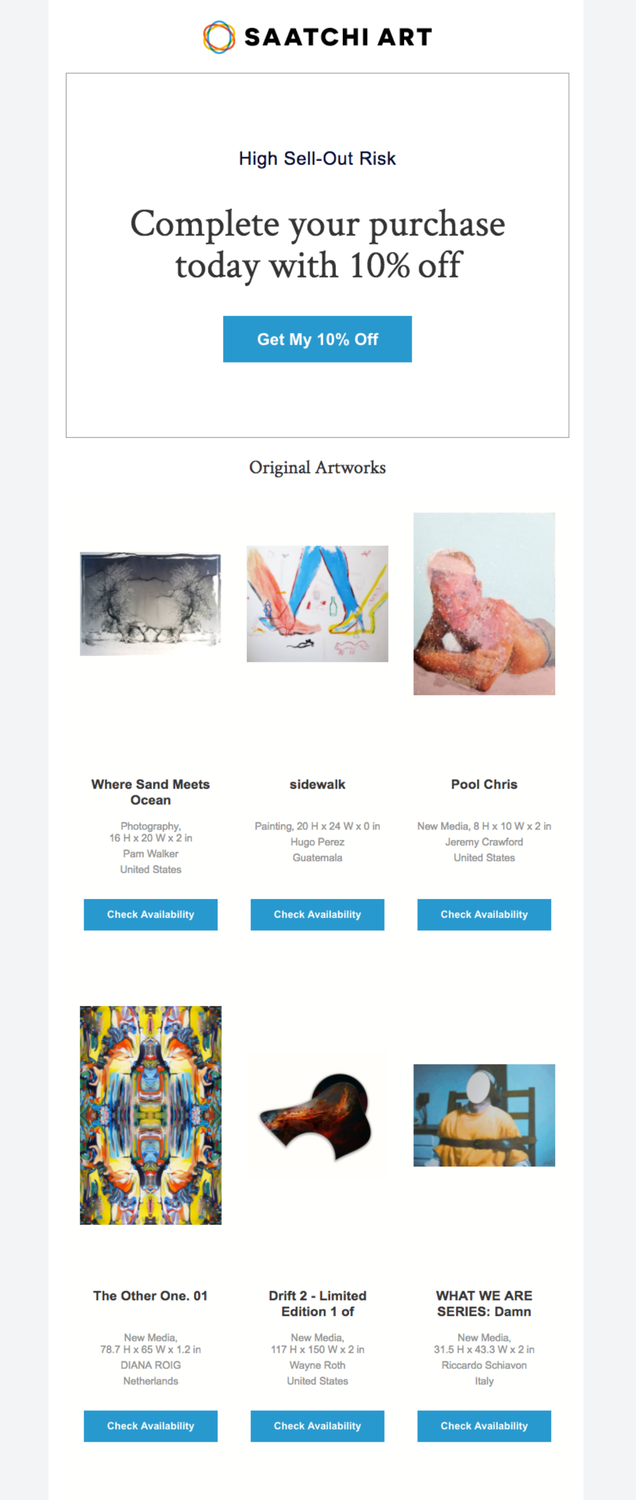
This art gallery incentivizes its online visitors to purchase original artworks at a discount price by sending them abandoned cart emails that contain a promocode. The email doesn’t say much, but it features multiple other artworks the recipient could be interested in — a timeless cross-selling tactic.
Start using abandoned cart emails to regain lost sales
Here’s a quick summary of what we’ve just talked about:
- Include three emails in your abandoned cart campaigns.
- Send the first email of your flow within an hour after the cart abandonment.
- Try and test different strategies to make your abandoned cart emails eye-catching and fun to read.
- Pay extra attention to your subject lines and use them to drive urgency.
- Use SendPulse to create automated abandoned cart emails that look and feel natural.
Create a free account now and give our platform a try!









